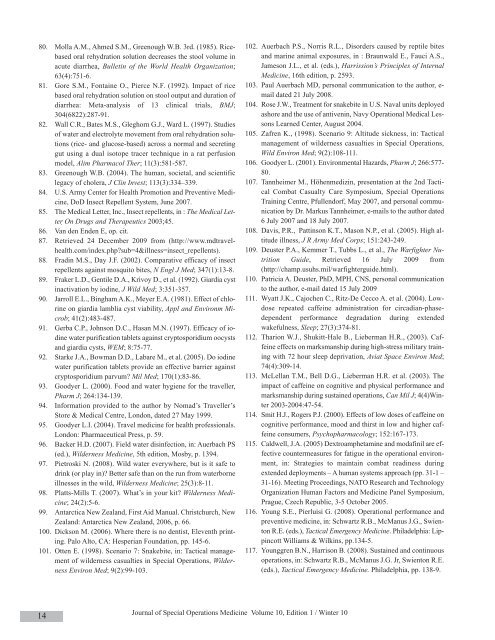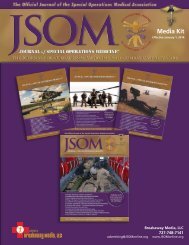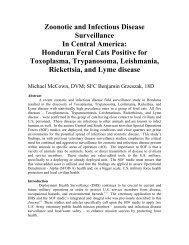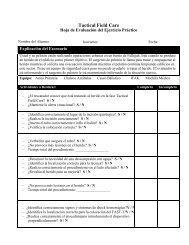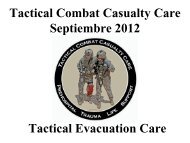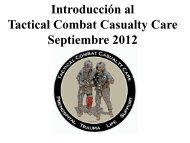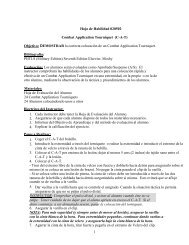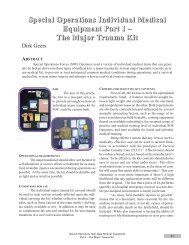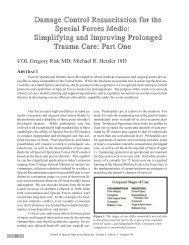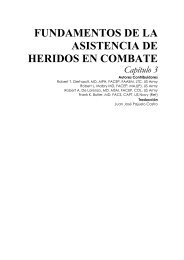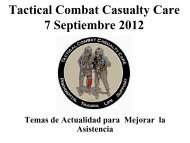Geers D. Special Operations Individual Medical Equipment Part 2
Geers D. Special Operations Individual Medical Equipment Part 2
Geers D. Special Operations Individual Medical Equipment Part 2
You also want an ePaper? Increase the reach of your titles
YUMPU automatically turns print PDFs into web optimized ePapers that Google loves.
80. Molla A.M., Ahmed S.M., Greenough W.B. 3rd. (1985). Ricebased<br />
oral rehydration solution decreases the stool volume in<br />
acute diarrhea, Bulletin of the World Health Organization;<br />
63(4):751-6.<br />
81. Gore S.M., Fontaine O., Pierce N.F. (1992). Impact of rice<br />
based oral rehydration solution on stool output and duration of<br />
diarrhea: Meta-analysis of 13 clinical trials, BMJ;<br />
304(6822):287-91.<br />
82. Wall C.R., Bates M.S., Gleghorn G.J., Ward L. (1997). Studies<br />
of water and electrolyte movement from oral rehydration solutions<br />
(rice- and glucose-based) across a normal and secreting<br />
gut using a dual isotope tracer technique in a rat perfusion<br />
model, Alim Pharmacol Ther; 11(3):581-587.<br />
83. Greenough W.B. (2004). The human, societal, and scientific<br />
legacy of cholera, J Clin Invest; 113(3):334–339.<br />
84. U.S. Army Center for Health Promotion and Preventive Medicine,<br />
DoD Insect Repellent System, June 2007.<br />
85. The <strong>Medical</strong> Letter, Inc., Insect repellents, in : The <strong>Medical</strong> Letter<br />
On Drugs and Therapeutics2003;45.<br />
86. Van den Enden E, op. cit.<br />
87. Retrieved 24 December 2009 from (http://www.mdtravelhealth.com/index.php?sub=4&illness=insect_repellents).<br />
88. Fradin M.S., Day J.F. (2002). Comparative efficacy of insect<br />
repellents against mosquito bites, N Engl J Med; 347(1):13-8.<br />
89. Fraker L.D., Gentile D.A., Krivoy D., et al. (1992). Giardia cyst<br />
inactivation by iodine, J Wild Med; 3:351-357.<br />
90. Jarroll E.L., Bingham A.K., Meyer E.A. (1981). Effect of chlorine<br />
on giardia lamblia cyst viability, Appl and Environm Microb;<br />
41(2):483-487.<br />
91. Gerba C.P., Johnson D.C., Hasan M.N. (1997). Efficacy of iodine<br />
water purification tablets against cryptosporidium oocysts<br />
and giardia cysts, WEM; 8:75-77.<br />
92. Starke J.A., Bowman D.D., Labare M., et al. (2005). Do iodine<br />
water purification tablets provide an effective barrier against<br />
cryptosporidium parvum? Mil Med; 170(1):83-86.<br />
93. Goodyer L. (2000). Food and water hygiene for the traveller,<br />
Pharm J; 264:134-139.<br />
94. Information provided to the author by Nomad’s Traveller’s<br />
Store & <strong>Medical</strong> Centre, London, dated 27 May 1999.<br />
95. Goodyer L.I. (2004). Travel medicine for health professionals.<br />
London: Pharmaceutical Press, p. 59.<br />
96. Backer H.D. (2007). Field water disinfection, in: Auerbach PS<br />
(ed.), Wilderness Medicine, 5th edition, Mosby, p. 1394.<br />
97. Pietroski N. (2008). Wild water everywhere, but is it safe to<br />
drink (or play in)? Better safe than on the run from waterborne<br />
illnesses in the wild, Wilderness Medicine; 25(3):8-11.<br />
98. Platts-Mills T. (2007). What’s in your kit? Wilderness Medicine;<br />
24(2):5-6.<br />
99. Antarctica New Zealand, First Aid Manual. Christchurch, New<br />
Zealand: Antarctica New Zealand, 2006, p. 66.<br />
100. Dickson M. (2006). Where there is no dentist, Eleventh printing.<br />
Palo Alto, CA: Hesperian Foundation, pp. 145-6.<br />
101. Otten E. (1998). Scenario 7: Snakebite, in: Tactical management<br />
of wilderness casualties in <strong>Special</strong> <strong>Operations</strong>, Wilderness<br />
Environ Med; 9(2):99-103.<br />
102. Auerbach P.S., Norris R.L., Disorders caused by reptile bites<br />
and marine animal exposures, in : Braunwald E., Fauci A.S.,<br />
Jameson J.L., et al. (eds.), Harrission’s Principles of Internal<br />
Medicine, 16th edition, p. 2593.<br />
103. Paul Auerbach MD, personal communication to the author, e-<br />
mail dated 21 July 2008.<br />
104. Rose J.W., Treatment for snakebite in U.S. Naval units deployed<br />
ashore and the use of antivenin, Navy Operational <strong>Medical</strong> Lessons<br />
Learned Center, August 2004.<br />
105. Zafren K., (1998). Scenario 9: Altitude sickness, in: Tactical<br />
management of wilderness casualties in <strong>Special</strong> <strong>Operations</strong>,<br />
Wild Environ Med; 9(2):108-111.<br />
106. Goodyer L. (2001). Environmental Hazards, Pharm J; 266:577-<br />
80.<br />
107. Tannheimer M., Höhenmedizin, presentation at the 2nd Tactical<br />
Combat Casualty Care Symposium, <strong>Special</strong> <strong>Operations</strong><br />
Training Centre, Pfullendorf, May 2007, and personal communication<br />
by Dr. Markus Tannheimer, e-mails to the author dated<br />
6 July 2007 and 18 July 2007.<br />
108. Davis, P.R., Pattinson K.T., Mason N.P., et al. (2005). High altitude<br />
illness, J R Army Med Corps; 151:243-249.<br />
109. Deuster P.A., Kemmer T., Tubbs L., et al., The Warfighter Nutrition<br />
Guide, Retrieved 16 July 2009 from<br />
(http://champ.usuhs.mil/warfighterguide.html).<br />
110. Patricia A. Deuster, PhD, MPH, CNS, personal communication<br />
to the author, e-mail dated 15 July 2009<br />
111. Wyatt J.K., Cajochen C., Ritz-De Cecco A. et al. (2004). Lowdose<br />
repeated caffeine administration for circadian-phasedependent<br />
performance degradation during extended<br />
wakefulness, Sleep; 27(3):374-81.<br />
112. Tharion W.J., Shukitt-Hale B., Lieberman H.R., (2003). Caffeine<br />
effects on marksmanship during high-stress military training<br />
with 72 hour sleep deprivation, Aviat Space Environ Med;<br />
74(4):309-14.<br />
113. McLellan T.M., Bell D.G., Lieberman H.R. et al. (2003). The<br />
impact of caffeine on cognitive and physical performance and<br />
marksmanship during sustained operations, Can Mil J; 4(4)Winter<br />
2003-2004:47-54.<br />
114. Smit H.J., Rogers P.J. (2000). Effects of low doses of caffeine on<br />
cognitive performance, mood and thirst in low and higher caffeine<br />
consumers, Psychopharmacology; 152:167-173.<br />
115. Caldwell, J.A. (2005) Dextroamphetamine and modafinil are effective<br />
countermeasures for fatigue in the operational environment,<br />
in: Strategies to maintain combat readiness during<br />
extended deployments – A human systems approach (pp. 31-1 –<br />
31-16). Meeting Proceedings, NATO Research and Technology<br />
Organization Human Factors and Medicine Panel Symposium,<br />
Prague, Czech Republic, 3-5 October 2005.<br />
116. Young S.E., Pierluisi G. (2008). Operational performance and<br />
preventive medicine, in: Schwartz R.B., McManus J.G., Swienton<br />
R.E. (eds.), Tactical Emergency Medicine. Philadelphia: Lippincott<br />
Williams & Wilkins, pp.134-5.<br />
117. Younggren B.N., Harrison B. (2008). Sustained and continuous<br />
operations, in: Schwartz R.B., McManus J.G. Jr, Swienton R.E.<br />
(eds.), Tactical Emergency Medicine. Philadelphia, pp. 138-9.<br />
14<br />
Journal of <strong>Special</strong> <strong>Operations</strong> Medicine Volume 10, Edition 1 / Winter 10


